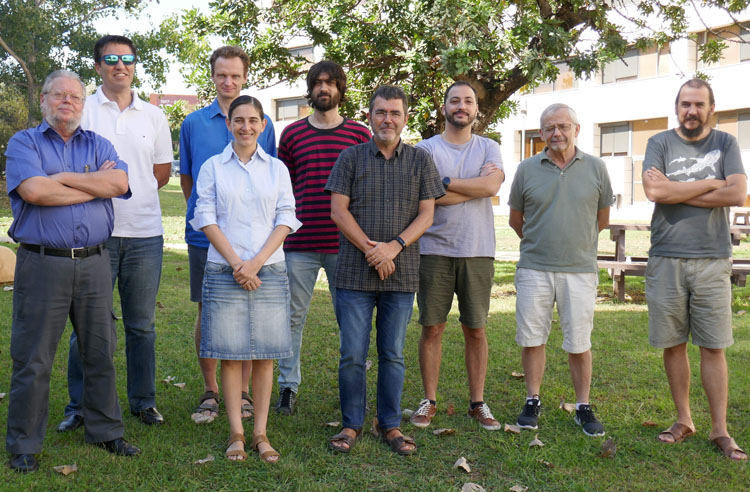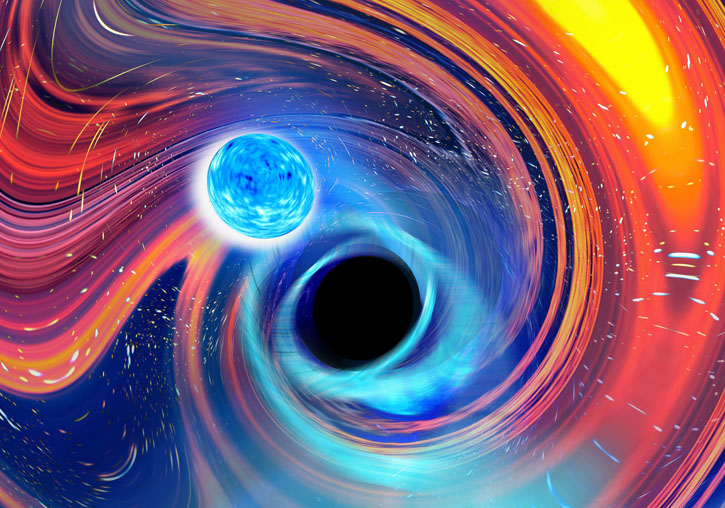The Virgo and LIGO collaborations observe the first “combined” pair of a black hole and a neutron star
- Scientific Culture and Innovation Unit
- June 29th, 2021
The international collaborations Virgo, LIGO and KAGRA have added a piece to the understanding of extreme cosmic phenomena: the first direct observation of pairs formed by a black hole and a neutron star. This is a completely new phenomenon, since the gravitational waves detected so far had been generated by pairs of black holes or pairs of neutron stars. José Antonio Font, professor of Astronomy and Astrophysics at the University of Valencia and Isabel Cordero, professor at the Faculty of Mathematics, are members of the UV research group on the Virgo scientific collaboration.

The discovery provides new insights into the complex mechanisms that could have generated these extreme and rare events, and, together with previous Virgo and LIGO detections, begins to shed light on a still unexplored cosmic landscape.
Scientific collaborations Virgo, LIGO and KAGRA announced today the first ever observation of binary systems made up of a neutron star (EN) and a black hole (AN). This has been possible thanks to the detection, in January 2020, of gravitational signals (labelled as GW200105 and GW200115 for the dates of their detections) emitted by two systems, in which a black hole and a neutron star, rotating one around the other, they merged into a single compact object. The existence of these systems was predicted by the astronomical community several decades ago, but they had never been observed for sure, either by electromagnetic or gravitational signals, until now. The result and its astrophysical implications were published today in The Astrophysical Journal Letters.
“Today's announcement once again highlights the enormous potential for the discovery of Gravitational Wave Astronomy”, points out José Antonio Font, researcher at the University of Valencia in the Virgo collaboration. “The two observed signals have once again confirmed a prediction advanced by theoretical models. It is very exciting to imagine what can happen with other theoretical proposals as the performance of current observatories increases”, Font concludes.
“We are in a moment of transition in gravitational wave astronomy: from the first individual detections of objects of a different nature that we are experiencing right now, to the numerous detections that are yet to come in the coming years and that will allow us to analyse globally the properties of populations of these objects”, points out Isabel Cordero Carrión, member of the dissemination and communication team of the Virgo collaboration and professor at the University of Valencia. “We will be revealing how objects are distributed of which, just a few years ago, we still had no proof of their existence, and analysing what possible role they play in the formation of structures and in the different astrophysical scenarios”.
The gravitational signals detected in January encode valuable information about the physical characteristics of the systems, such as the mass and distance of the two neutron star and black hole pairs (NSBH), as well as the physical mechanisms that have generated these objects. and have caused them to collapse. Analysis of the signal has shown that the black hole and the neutron star that originated GW200105 are, respectively, around 8.9 and 1.9 times as massive as the Sun and that their merger took place around 900 million years ago, hundreds of millions of years before the first dinosaurs appeared on Earth. In the case of the GW200115 event, Virgo, LIGO, and KAGRA scientists estimate that the two compact objects were about 5.7 (for BH) and 1.5 (for NS) times the mass of the Sun and that they merged ago almost a billion years.
Prediction
The estimate of the mass of the most massive object in both cases falls within the predicted fit range for the black holes formed in the stellar evolution models. The lighter mass is also consistent with neutron stars, and those results indicate that both detected systems are NSBH pairs, even if they have different confidence levels. In this sense, although the statistical significance of GW200105 is not that high, the “shape” of the signal, as well as the parameters inferred from the analyses, lead researchers to believe that it has an astrophysical origin.
An additional test of the detection of a mixed system of a neutron star and a black hole could have been the detection of electromagnetic radiation along with gravitational waves. In fact, if the masses of the two compact objects are roughly comparable, the neutron star, as it approaches the black hole, is subject to such tidal forces that it fragments. In this case, in addition to gravitational emissions, a spectacular flare of electromagnetic radiation could also be observed, due to the disintegration of stellar matter around the black hole: a mechanism similar to what leads to the formation of accretion discs around giant black holes at the centre of galaxies. This probably happened neither for GW200105 nor for GW200115, since in both cases the mass of the black hole was very large, so once the separation between the two objects was small enough, the black hole, so to speak, swallowed his partner in a single bite.
Article:
Abbot et al. 2021, ApJL, 915, L5. DOI: 10.3847/2041-8213/ac082e
URL (inactive until embargo time): https://iopscience.iop.org/article/10.3847/2041-8213/ac082e
Photo caption:
- Rainbow Swirl artistic image, inspired by the merger of a black hole and a neutron star. Credit: Carl Knox, OzGrav - Swinburne University.
More information:
Virgo http://www.virgo-gw.eu
Ligo: https://my.ligo.org/census.php.
KAGRA: https://gwcenter.icrr.u-tokyo.ac.jp/en/.
Contribution in Spain:
Six Spanish groups contribute to the study and analysis of the gravitational waves detected by LIGO Virgo, in areas ranging from theoretical modelling of astrophysical sources and data analysis to improving the sensitivity of the detectors for current and current and future observation periods. Two groups, at the University of the Balearic Islands (UIB) and the Galician Institute of High Energy Physics (IGFAE) of the University of Santiago de Compostela (USC), are part of the LIGO Scientific Collaboration; while the University of Valencia (UV), the Institute of Cosmos Sciences of the University of Barcelona (ICCUB), the Institute of High Energy Physics (IFAE) of Barcelona and the Institute of Theoretical Physics (IFT) of the Autonomous University of Madrid-CSIC are members of Virgo.
Gravitational wave observatories:
The Virgo Collaboration is currently made up of approximately 700 members from 126 institutions in 15 different countries (mainly in Europe). The European Gravitational Observatory (EGO) houses the Virgo detector near Pisa, Italy, and is funded by the Center National de la Recherche Scientifique (CNRS) in France, the Istituto Nazionale di Fisica Nucleare (INFN) in Italy, and Nikhef in the Netherlands.
A list of the Virgo Collaboration groups can be found at
http://public.virgo-gw.eu/the-virgo-collaboration/.
LIGO has been funded by the National Science Foundation (NSF) and operated by Caltech and MIT, who conceived LIGO and led the project. The NSF, together with Germany (Max-Planck Society), the United Kingdom (Science and Technology Facilities Council) and Australia (Australian Research Council - OzGrav), led the financial support for the Advanced LIGO project, bringing significant commitments and contributions to the project. Approximately 1,300 scientists from around the world participate in the work of the LIGO Scientific Collaboration, which includes the GEO Collaboration. A list of additional contributors is available at https://my.ligo.org/census.php.
The KAGRA laser interferometer, with 3-kilometer long arms, is located in Kamioka, Gifu, Japan. The institute that hosts it is the Institute of Cosmic Ray Researches (ICRR) at the University of Tokyo, and the project is co-funded by the National Astronomical Observatory in Japan (NAOJ) and the High Energy Accelerator Research Organisation (KEK). KAGRA completed its construction in 2019, and subsequently joined the international gravitational wave network of LIGO and Virgo. More information about KAGRA can be found on their website at https://gwcenter.icrr.u-tokyo.ac.jp/en/.



















